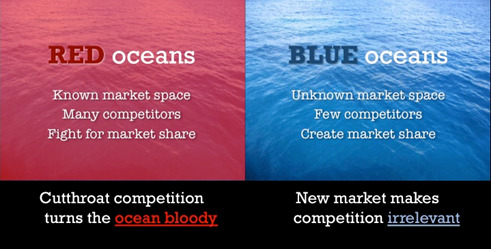Strategy
|
|
Crafting your strategies to grow your business is the next key thing you will need to do on this business excellence journey.
Just over 10 years ago, doing strategy is really about doing your Business Plan (BP).
Some may call it a Strategic Business Plan (SBP) or an Information Memorandum (Info Memo).
The difference really lies in terms of content and the purpose for which it is written.
|
 |
For this section, you will realize we are using “BLUE” for the Tables. This is deliberate and a link to the famous book called “Blue Ocean Strategy”.
Basically we should identify a Strategy in an uncontested space where we need not fight with a lot of competitors.
Create a new space and niche from which you can do business profitably.
That is the spirit of the “Blue Ocean Strategy”.
|
|
|
1 Page Business Plan (1BP) |
Strategic Business Plan (SBP) |
Business Plan (BP) |
Information Memorandum (Info Memo) |
|
For who |
Purely for Internal use.
Advisable for all companies to use this BUT especially useful for Micro or Small to Medium businesses that may not have the resources to do a full BP or a SBP.
|
Can be for both Internal and External use.
Typically used for Medium to Large sized businesses. |
Internal Use – typically every Heads of Department (HODs) will have a copy with their portion inside as a reference.
Usually carried out by Bigger firms that has a few departments and fairly big business scale and Multi-national companies (MNCs).
|
The Info Memo (or Information Memorandum) is usually crafted as a Document for investors.
Usually for companies looking to raise funds or for M&A purposes (Mergers and Acquisition). |
|
Purpose |
This is a facilitated process conducted by a trained consultant or business coach.
All the key people in the company will participate in this process.
The Facilitator will use various tools and a proprietary methodology to get the job done.
|
For internal use, every HODs will usually have this copy for reference. They will then craft out their own operations plan to support the strategy written.
For the Board of Directors (BOD) level, the SBP helps them to focus on the big picture.
This is especially useful for bosses with multiple businesses to look after.
|
Usually very thick and it usually serves as both a Strategy and Operation Guide.
The BP allows everyone to know what each other / departments are doing in order to manage their operations and to align what they do to the overall big picture.
The BP will also have what you call the Balanced Scorecard and KPIs (Key Performance Indicators) inside. This gives all the HODs a clear picture of what is expected from them.
|
This document is usually produced for the purpose of fund raising or for M&A purposes.
It will cover all the key business info and written for the view of the external parties. It will also have all the key investment term sheets for investors to make decisions.
Usually very well produced and a work of art akin to that of the typical Annual Report standard in terms of design and production. |
|
Who writes it |
Everyone will give their input but the Facilitator will be the one who will document down the 1 page business plan for the client.
The 1 page business plan is very comprehensive and helps you monitor performance. |
Usually written by either a very senior level person (supported by a team to put it together) or by an external consultant.
It will usually covers key market studies and research as inputs for the companies to develop their strategies. |
Usually done by all the HODs (for the individual departments) after they get the overall direction or SPB from the Boss. There is usually one person appointed to put the BP together.
An external consultant may be invited to help put it together and to help the HODs with their portion.
|
Typically written by an external agency or consulting firm in consultation with the company senior management team.
It will involves the accountants and lawyers who will knock out the term sheet and help the client negotiate the deal. |
|
Review |
The 1 page BP is done every year with Quarterly and Monthly built in.
|
The SBP is usually reviewed every 3 or 5 years.
|
This plan is usually reviewed once a year or bi annually.
|
Usually done for a specific purpose and will be reviewed as and when needed for new opportunities. |
Benefits of doing this Phase
 |
There is a wise saying “If you fail to plan, you plan to fail”.
This will sum up what we are trying to do over here.
One of the main best practice of all successful and fast growing companies is this : they all have a plan and they actively review it as they going along, making changes according to market changes but using it constantly as a compass and guide to what they are doing. |
Strategy Hacks
Strategy is Not Simple
This process should ideally be done by a trained professional. It sounds simple, but the process of managing the different personalities and politics is not as straight forward as we would like to think. Everyone is competing for scarce resources and each will try to protect their own turf and territories. You do need someone objective to come in and to speak up without any fear of future repercussion. The experienced consultant is also able to speak firmly and objectively for the good of the company.
Having said that, it is also not cheap to hire all these professionals. They are usually very good at what they do and they do command certain market rates to do their job. Please do not offer them internship or fresh graduate pay rate because if you do so, you might as well hire an intern or fresh grad to facilitate for you. So do your math and be wise in managing them.
Hack # 1 : Use the Resources in this portal (video trainings, templates, training materials and notes, PDF and ebooks etc)
We have a training on how to craft your Business Plan. You can let all the HODs learn from the Videos and then using it as a guide, go on to create your own Business Plan. Just be mentally prepared that as it is not something your team may do regularly, you can expected steep learning curve, some form of struggle and resistance as this project adds on to their current workload. So in the training, we will address some of these practical issues and constraints and show you how to circumvent it and do a good job.
Hack # 2 : Use MBA Interns to help with your Market Research
Most universities will have an MBA programs with an Internship module. If you do not wish to spend thousands of dollars for a Market Research Agency or a Top Notch Consultancy Firm to do your market research for you, you can apply to your local university for an MBA intern to help you do your market research work. The other plus point is that most students will also have access to school databases and as such, they will be able to help you pull out lots of useful and helpful research papers and data to help you craft out the business plan.
For market research, you can still get away with using “Undergraduates Intern” getting their first degree or bachelor degree to do the work. But you probably will not want to use them to “put together” the business plan as they may not have the breadth and depth of experience to do so. And it will probably take you more time to engage and teach them what to do in the first place.
Hack # 3 : Use MBA Interns to “assemble” the Business Plan
Most MBA students have a big appetite for “Strategy” work and you can put this passion they have to good use by tapping on them to help you put together the business plan.
Having said that, you need to be mindful of a few things. First, they may not have that industry experience to provide that kind of strategic insights that only a professional consultant can give. As such, they may play the role of “assembling the business plans” from all the plans that the various HODs does.
Second, be mentally prepared that they may “EXPECT” you to adopt their plan and ideas, never mind the fact that most of them may come up with stuff that is probably not workable and they will not be around to see it through. The fact of the matter is a lot of students today have such a sense of confidence from years of “affirmative behavior conditioning” where parents and teachers praise them for every little bit of achievement no matter how small they are – that they end up with a pretty big self-belief system that what they do and say is the best and always right.
So prevent all these unnecessary hassle by setting clear expectations from the start. Conduct your interview process well and if you sense that they are not open for feedback or correction, you may wish to evaluate other candidates instead. For this part of the work, getting an MBA intern is the best option. Undergrad Intern may not have that maturity and exposure to do so.
